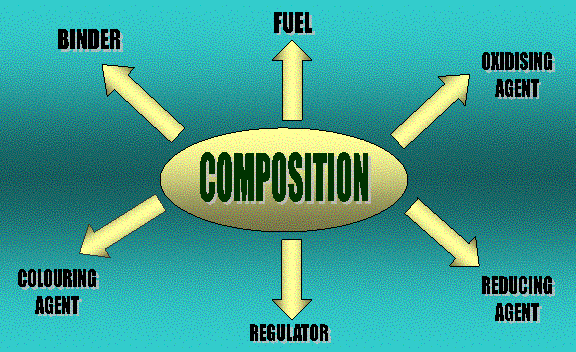http://www.ch.ic.ac.uk/local/projects/gondhia/composition.html
Composition
The Chemistry of fireworks is based on the simple theory of combustion. The composition inside the firework must however contain 6 vital ingredients:
Fuel
Charcoal, commonly known in the pyrotechnic industry as black powder is the most common fuel used in fireworks. Normally, all fuels will contain an organic element such as charcoal or thermite.The mechanism by which the fuel functions in the firework is relatively simple. The fuel loses electrons to atoms within the oxidiser (thereby reducing the oxidiser) and releasing atoms from the oxidiser. During this process, bonds are formed between the fuel and oxygen atoms forming a product which is relatively stable. However, only a minimal amount of energy is required to start the combustion of this fuel-oxidiser compound. When combustion does start, the result is a massive release of energy as the solid mixture liquefies and vaporises into the flame of ignition. This maximises the probability of reaction of the oxidiser as it is brought into the close proximity of the flame.
Oxidising Agents
The function of the oxidising agent is to produce the oxygen needed in order for the mixture inside the firework to burn. These oxidisers can be nitrates, chlorates or perchlorates.On the contrary, Chlorates get completely reduced as they are better oxidising agents and so cause an even more spectacular reaction. This however does cause the reaction to become extremely explosive.
Reducing Agents
The second part to a firework is the reducing agent. These burn the oxygen provided by the oxidising agents to produce hot gasses.Common reducing agents are Sulphur and Charcoal. These react with the oxygen to form Sulphur dioxide and Carbon dioxide respectively as illustrated below.
 By mixing both the reducing agents, the speed of the reaction can be controlled.
By mixing both the reducing agents, the speed of the reaction can be controlled. Regulators
Metals can be added to regulate the speed at which the reaction. The larger the surface area of the metal, the faster the reaction will proceed (collision theory).Colouring Agents
Different chemicals are used to produce different coloured fireworks. Therefore, in order to produce a firework of a certain colour, the correct corresponding chemical or as the case may be, mixture of chemicals can be used:| Metal | Colour |
|---|---|
| Strontium | Red |
| Copper | Blue |
| Barium | Green |
| Sodium | Yellow/Orange |
| Calcium | Orange |
| Gold | Iron |
The incandescence from the elements occurs when solid particles are heated in the flame to extremely high temperatures. These release excess energy in the form of light (hv) at the broad end of the spectrum. The higher the temperature, the shorter the wavelength at which light is emitted, and the nearer it tends toward the blue end of the coloured spectrum. This is why blue coloured fireworks are so hard to synthesise, as they only occur at very high temperatures.
No comments:
Post a Comment